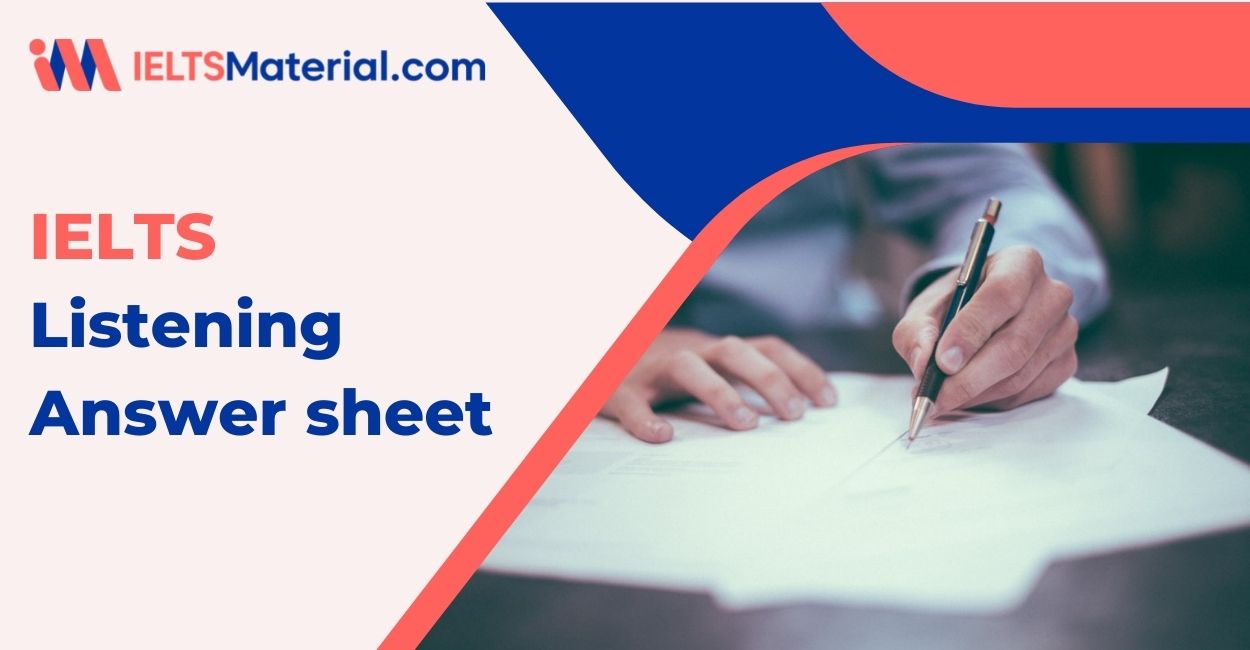IELTS Listening Answer Sheet
4 min read
Updated On
-
Copy link
Ready to take a sneak peek at what an IELTS Listening answer sheet looks like? Then read this article so that you can also find our expert tips on how to fill it on your exam day as well!
Table of Contents

Limited-Time Offer : Access a FREE 10-Day IELTS Study Plan!
The IELTS Exam is a test of all 4 language skills, i.e., the ability to listen, read, write, and speak in English. The IELTS Listening tests your ability to understand and grasp information and follow the development of ideas. The recordings will be of native English speakers.
About the IELTS Listening Test
The IELTS Listening recording audio will last for 30 minutes (PBT). So these 30 minutes are for listening to the audio and writing your answers on the question paper. After which those attempting the test via paper-based will be given an extra 10 minutes to transfer their answers to the answer sheet.
Those attempting the test via IELTS computer-based will be given an extra 2 minutes to review their answers. The Listening section is one of the easiest sections to boost your band score.
How Does an IELTS Listening Answer Sheet Look?

Different Sections of the IELTS Listening Answer Sheet
- Make sure to fill up the form using a pencil. The context for the Listening test answer sheet is given below.
- Starting from the top, at first, you’ll have to enter your centre number.
- The centre number could include letters as well as numbers in it.
- After writing the centre number code, the examiner may ask you to write your city name next to it. For example – MD850 Madrid ( MD850 the centre number code, while Madrid is the city).
- The next step would be to write your full name in capital letters (as is in your passport). Make sure to write it clearly.
- After that, you’ll have to fill in your candidate number. The number will be given to you at the test centre.
To ace your IELTS Listening on your test day, Get our expert’s help!
- You’ll have to write the date – with the date, month and year, by shading the given number boxes.
- After filling in all your basic information, you’ll see the two columns, numbered from 1 – 40, where there’ll be space to write your answers next to each number.
- Make sure to write down the answers with a dark and sharpened pencil.
- For each answer, write them in the extreme left of the answer box, near the serial number, and not from the centre of the box.
- There is a section in the answer column with the title, ‘Marker use only’ avoid writing anything in that section, as it’s meant only for the examiner.
- You’ll also notice four boxes below the answer column, and even those are meant for the examiners only, so avoid writing anything in there as well.
8 Key Tips for the IELTS Listening Exam
- Read the instructions on the paper carefully.
- Write your full name in capitals on the answer sheet
- Use a pencil while writing the answers on your answer sheet.
- During the test, while the recording is going on, you’ll have to write the answer on the Listening question paper.
- After the recording is over, you’ll have 10 minutes to write the answer in the answer sheet.
- You must use these 10 minutes to check the spelling of your answers.
- If you miss an answer, keep calm and move on.
- Even still, try to attempt all the questions, even if you have to guess.
Instructions Given During the IELTS Listening Exam
- During the exam, you’ll be given the following instructions.
- Not to open the question paper until told.
- Write the full name and application number at the top of the page.
- Write your answers on the question paper while you’re listening.
- At the end of the audio, you will have 10 minutes to transfer your answers onto the separate answer sheet.
Practising on the IELTS Listening Answer Sheet & Following E-Books
It is very important to remember that during the Listening Test, you’ll only hear the recording once. While the recording is being played out, you’ll need to focus and listen to the recording, read the questions, and answer them at the same time.
The more you listen to E-Books, the more you’ll get used to understanding a range of English accents.
The more you practice on the answer sheet, the more relaxed you’ll be while attempting the actual exam. The more relaxed you are then, the more efficiently you’ll be able to use the 10 minutes you have, to transfer your answers to the answer sheet without any spelling or grammatical errors.
Improve Your Listening Skills with IELTSMaterial.com
Note that practice is the key! If you’re fully prepared for your IELTS Listening day, it should be an easy ride for you. Every student who scores a 7 or better on the test will tell you that planning is important, alongside working hard to hone listening skills. To get started, get help from our IELTS experts or attend our FREE webinars to learn tricks to improve your listening skills!
Also Check:
Frequently Asked Questions
Can I answer while listening to the audio?
Can I write words, or do the answers need to be in letters in the MCQ?
What is the first thing to fill in the IELTS Listening answer sheet?
Which section in the IELTS Listening answer sheet shouldn't be touched by the test takers?
Should I use a pen or a pencil in the IELTS Listening test?

Start Preparing for IELTS: Get Your 10-Day Study Plan Today!
Explore other Listening Topics

Kasturika Samanta

Nehasri Ravishenbagam

Nehasri Ravishenbagam
Recent Articles

Kasturika Samanta

Prity Mallick

Haniya Yashfeen

Kasturika Samanta





Post your Comments
4 Comments